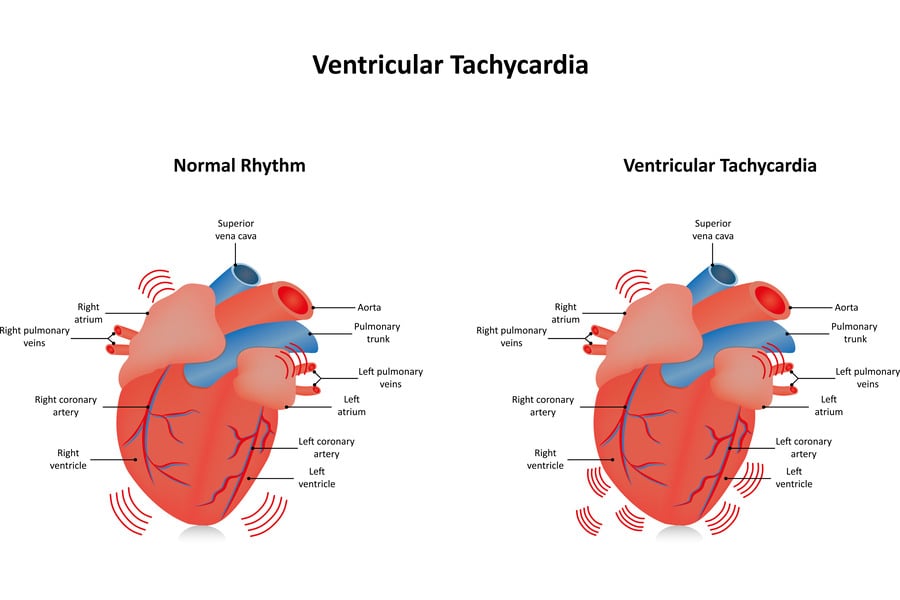Ventricular tachycardia (VT) is a fast, abnormal heart rhythm originating in the lower chambers of the heart (ventricles). It is considered a type of arrhythmia and can lead to reduced blood flow to the rest of the body, including the brain, and may cause dizziness, fainting, or, in severe cases, sudden cardiac arrest.
Overview
Ventricular tachycardia can occur for a few seconds (non-sustained) or can last for more than 30 seconds (sustained). Non-sustained VT usually doesn’t cause serious problems, but sustained VT can be life-threatening and requires immediate medical attention.
Symptoms
The symptoms of VT can vary depending on the duration and rate of the abnormal heart rhythm, as well as the individual’s overall heart health. Common symptoms include:
- Palpitations (a rapid, fluttering, or pounding heart)
- Dizziness or lightheadedness
- Shortness of breath
- Fatigue or weakness
- Fainting (syncope)
- Chest pain
Causes
Ventricular tachycardia is often caused by other heart-related issues. Common causes include:
- Heart attack: Scar tissue from a previous heart attack can interfere with the heart’s electrical signals, leading to VT.
- Heart disease: Coronary artery disease, high blood pressure, and other heart conditions can increase the risk of VT.
- Cardiomyopathy: Enlargement and thickening of the heart muscle can disrupt the heart’s electrical system, causing VT.
- Electrolyte imbalances: Abnormal levels of potassium, calcium, or other electrolytes can affect the heart’s electrical activity.
- Recreational drug use: Some recreational drugs, such as cocaine or methamphetamine, can trigger VT.
- Genetics: Certain genetic conditions, like long QT syndrome, can predispose an individual to VT.
Risk Factors
Risk factors for VT include:
- Heart conditions: Having a heart attack, heart disease, or cardiomyopathy increases the risk of VT.
- Family history: A family history of VT or other heart rhythm disorders increases the risk.
- Recreational drug use: Some recreational drugs can trigger VT.
- Older age: VT is more common in older adults, particularly those with heart conditions.
Prevention
Preventing ventricular tachycardia involves managing risk factors and addressing any underlying heart conditions:
- Adopt a heart-healthy lifestyle: Eat a balanced diet, exercise regularly, maintain a healthy weight, and manage stress.
- Control heart disease risk factors: Manage high blood pressure, cholesterol levels, and diabetes.
- Avoid recreational drug use: Steer clear of recreational drugs that can trigger VT.
- Follow your treatment plan: If you have a heart condition, follow your doctor’s recommendations for medication and lifestyle changes.
When to See a Doctor
If you experience symptoms of VT, such as palpitations, dizziness, or fainting, seek medical attention immediately. Even if your symptoms are brief, consult a healthcare professional to evaluate your heart health.
Treatment and Management
Treatment for VT depends on the cause, severity, and frequency of the episodes. Options include:
- Medications: Antiarrhythmic drugs can help regulate heart rhythm.
- Cardioversion: Electric shocks restore a normal heart rhythm.
- Catheter ablation: Damaged heart tissue causing the abnormal rhythm is destroyed.
- Implantable devices: An implantable cardioverter-defibrillator (ICD) can detect and correct abnormal heart rhythms.
- Lifestyle changes: Heart-healthy habits can help manage VT.
Additional Information:
Pediatric Ventricular Tachycardia
Ventricular tachycardia can also occur in children, even those with a healthy heart. In pediatric cases, VT may result from congenital heart defects, inherited arrhythmia syndromes, or certain medications. Treatment may include medication, lifestyle changes, and in some cases, surgery.
Exercise-induced VT
Some people may experience ventricular tachycardia during or after intense physical activity. Exercise-induced VT is often seen in individuals with genetic heart conditions like catecholaminergic polymorphic VT or arrhythmogenic right ventricular cardiomyopathy.
Monomorphic vs. Polymorphic VT
VT can be categorized as monomorphic or polymorphic. In monomorphic VT, the abnormal heartbeats have a consistent pattern, while in polymorphic VT, the pattern is irregular. Polymorphic VT is often more dangerous and may be associated with conditions like long QT syndrome.
VT in Pregnancy
VT can occur during pregnancy due to hormonal changes, increased blood volume, or stress on the heart. Pregnant women with VT may require specialized care to manage the condition while ensuring the safety of both mother and baby.
In conclusion, Ventricular tachycardia is a fast, abnormal heart rhythm that can be life-threatening if sustained. Understanding the causes, symptoms, and risk factors is essential for managing and preventing VT. Consult a healthcare professional if you experience symptoms or have concerns about your heart health.









